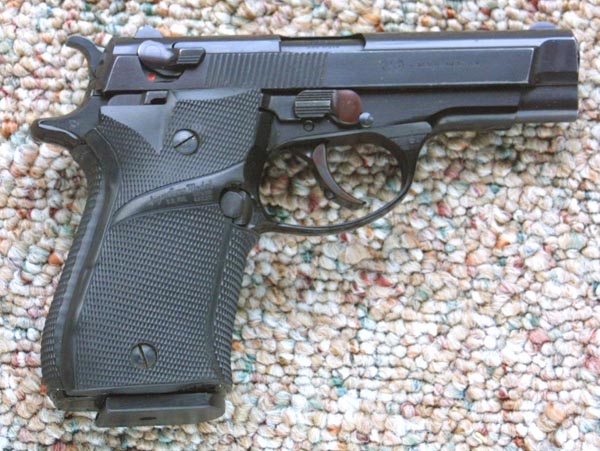 Browning BDA
Browning BDA
| Length Overall | Barrel Length | Weight | Caliber | Action Type | Magazine capacity |
| 6.8 Inches | 3.8 Inches | 24 oz | .380 | Semi-auto, blowback | 13+1 |
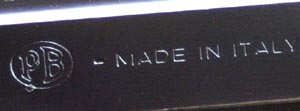 This is one, of two, pistols that Browning
has called the BDA. Neither of the aforementioned guns is made by Browning
itself. Both of these models are factory runs of different manufactures,
sold to Browning by lot, and marketed under it's own label. This is not
uncommon in the electronics industry, and has happened in a few cases (S&W
shotguns, Weatherby rifles, some offerings of Springfield Armory) in the
firearms industry. The model we are not concerned with here, is a full sized
semi-auto produced by Sauer, based on their 220 model, and chambered in .45,
and 9mm. The other BDA, The one featured on this page, is a medium/small
frame auto, made by Beretta, and based upon their M-84. Both models are double
action automatics. The smaller, Beretta based BDA, is a high quality gun
suited to casual carry, and self defense.
This is one, of two, pistols that Browning
has called the BDA. Neither of the aforementioned guns is made by Browning
itself. Both of these models are factory runs of different manufactures,
sold to Browning by lot, and marketed under it's own label. This is not
uncommon in the electronics industry, and has happened in a few cases (S&W
shotguns, Weatherby rifles, some offerings of Springfield Armory) in the
firearms industry. The model we are not concerned with here, is a full sized
semi-auto produced by Sauer, based on their 220 model, and chambered in .45,
and 9mm. The other BDA, The one featured on this page, is a medium/small
frame auto, made by Beretta, and based upon their M-84. Both models are double
action automatics. The smaller, Beretta based BDA, is a high quality gun
suited to casual carry, and self defense. 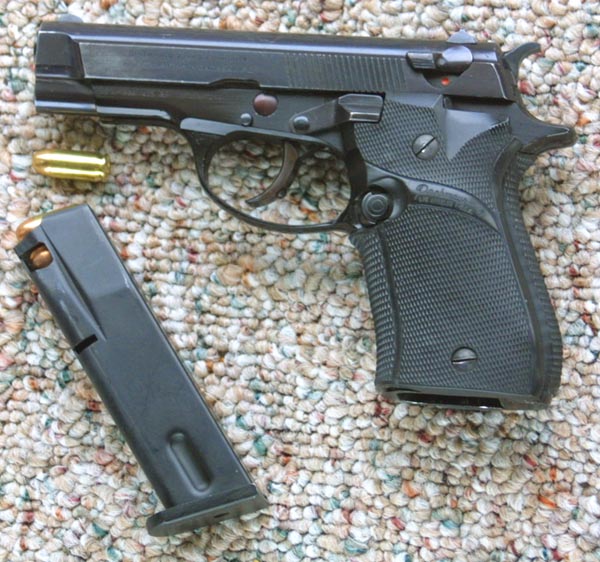 This is a straight blowback pistol, with no
lock up. This method of recoil operation is common in pistols of this caliber,
and is sufficient for the power of the .380 round. Though built by
Beretta, using the same machinery, and design as the Model 84, the little
BDA lacks the distinctive Beretta open topped slide. It also features an
ambidextrous slide mounted safety, rather than the frame mounted safety
of the Beretta version. In all other respects the two guns are basically
the same model. It was offered from 1977, until 1997; though I notice that
there is a limited edition reissue 2006 model available from Browning, in
nickel finish only.
This is a straight blowback pistol, with no
lock up. This method of recoil operation is common in pistols of this caliber,
and is sufficient for the power of the .380 round. Though built by
Beretta, using the same machinery, and design as the Model 84, the little
BDA lacks the distinctive Beretta open topped slide. It also features an
ambidextrous slide mounted safety, rather than the frame mounted safety
of the Beretta version. In all other respects the two guns are basically
the same model. It was offered from 1977, until 1997; though I notice that
there is a limited edition reissue 2006 model available from Browning, in
nickel finish only.The blue version of this gun has a black, alloy frame, and a richly blued (almost black enough to match the frame) steel slide. The later models were shipped with the clinton mandated 10 round magazines, but the design capacity of the gun is 13 rounds. I have a preban model, which came with one of the old 13 rounders, but the hi-cap magazines will also fit the newer guns. Whatever the capacity, these are staggered, double column magazines, and give the grip a bit more purchase than most other guns in this caliber. This makes the BDA, very comfortable to shoot; but a bit less concealable than some competitive offerings, like the Walther PPK. As far as I know, this is the only large capacity pistol designed for the 380, or for any other minor level cartridge. My only real complaint about the gun is it's magazine safety, a feature that I never saw much use for. One other minor irritation, is the hammer drop safety, which renders the gun incapable of being carried "cocked, and locked" like a big forty five. Neither of these is anything major, and neither is unique to the BDA.
The magazine catch is located behind the trigger, rather than at the base of
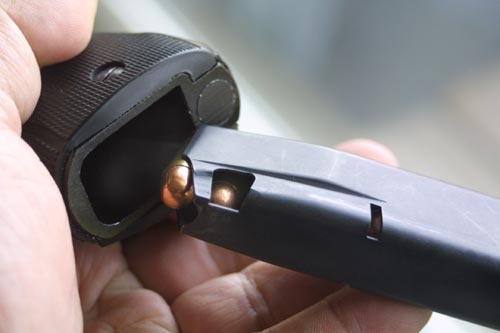 the magazine as is the case with many European style autos. The slide stop,
and safety are also right where the American shooter would expect them to
be. The sights are reasonably good, a bit better than is generally expected
of this type of gun, and are drift adjustable. The single action trigger
pull is light, and crisp, with no more take up than one would anticipate
in a double action gun. The double action pull itself is smooth, and quite
light. The wide trigger, and smooth pull, along with the wide grip, make
this a considerably easier gun to shoot than the PPK. These features, along
with the good sights, and hefty grip, make the gun a bit more accurate too.
The
.380 caliber cartridge, is a shortened version of the 9mm, and is considered
to be an adequate defense round. It is generally thought to define the lower
end of power judged suitable for defensive use. The gun is easy to take down
for cleaning. A push on a small locking pin, allows the take down lever to
pivot, so that the slide may be simply pushed forward off the frame; simple.
This gun also features a loaded chamber indicator, which is basically just
a bit of red paint on the extractor, and a slide hold open when the magazine
empties. I have personally never thought much of loaded chamber indicators,
and feel that placing one's trust in such a thing, is an accident waiting
to happen.
the magazine as is the case with many European style autos. The slide stop,
and safety are also right where the American shooter would expect them to
be. The sights are reasonably good, a bit better than is generally expected
of this type of gun, and are drift adjustable. The single action trigger
pull is light, and crisp, with no more take up than one would anticipate
in a double action gun. The double action pull itself is smooth, and quite
light. The wide trigger, and smooth pull, along with the wide grip, make
this a considerably easier gun to shoot than the PPK. These features, along
with the good sights, and hefty grip, make the gun a bit more accurate too.
The
.380 caliber cartridge, is a shortened version of the 9mm, and is considered
to be an adequate defense round. It is generally thought to define the lower
end of power judged suitable for defensive use. The gun is easy to take down
for cleaning. A push on a small locking pin, allows the take down lever to
pivot, so that the slide may be simply pushed forward off the frame; simple.
This gun also features a loaded chamber indicator, which is basically just
a bit of red paint on the extractor, and a slide hold open when the magazine
empties. I have personally never thought much of loaded chamber indicators,
and feel that placing one's trust in such a thing, is an accident waiting
to happen. The 380 is gaining in popularity, in part because new cartridge developments claim to make the sub 1000 fps round expand reliably. I have not tested this
This gun begs for comparison with the Walther PPK, or PPK/S, not only because of the caliber fired; but because of the similarity in operation, the comparable size, and the role which both were designed to fill. A side by side photo of the BDA
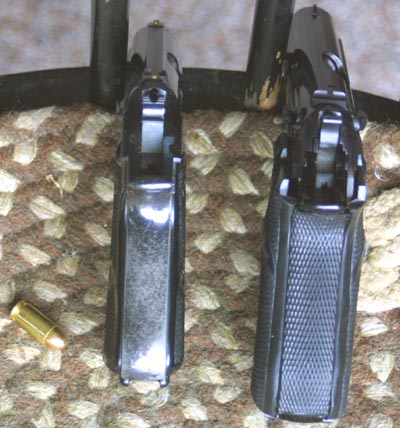 alongside my well worn PPK/S, is shown to the left. The BDA has twice the
capacity of the PPK, though this slightly compromises it's concealability.
The PPK is fairly unpleasant to shoot, compared to the BDA, in large measure
because of the extra width in the grip of the little Browning. The double
action pull of the BDA is far superior to that of the PPK, though the single
action pulls are about the same, being perhaps a shade lighter on the PPK.
Though each of these guns is designed to hold the action open after the last
shot is fired, the BDA has an external slide release, while the slide of
the PPK needs to be pulled back in order to close the action. Both guns were
designed for police use, rather than military applications, and both have
been adopted by European police departments. In both cases, these medium
framed guns have been popular with civilian users. The BDA is slightly longer,
and slightly taller than the PPK, making it about the same height as the
PP, or PPK/S. The Browning, with it's alloy frame, is lighter than the PPK/S,
and about an ounce heavier than the PPK. Of the two, frankly, I prefer the
Browning.
alongside my well worn PPK/S, is shown to the left. The BDA has twice the
capacity of the PPK, though this slightly compromises it's concealability.
The PPK is fairly unpleasant to shoot, compared to the BDA, in large measure
because of the extra width in the grip of the little Browning. The double
action pull of the BDA is far superior to that of the PPK, though the single
action pulls are about the same, being perhaps a shade lighter on the PPK.
Though each of these guns is designed to hold the action open after the last
shot is fired, the BDA has an external slide release, while the slide of
the PPK needs to be pulled back in order to close the action. Both guns were
designed for police use, rather than military applications, and both have
been adopted by European police departments. In both cases, these medium
framed guns have been popular with civilian users. The BDA is slightly longer,
and slightly taller than the PPK, making it about the same height as the
PP, or PPK/S. The Browning, with it's alloy frame, is lighter than the PPK/S,
and about an ounce heavier than the PPK. Of the two, frankly, I prefer the
Browning. My particular gun is equipped with Pachmeyer rubber grips, and came with a single, 13 round magazine. The gun is capable of 3" groups, at least in my hands, and is an absolute pleasure to shoot. The fit and finish are wonderful, as are the handling qualities. The combination of fairly easy recoil, small size, and comfortable grip width, would make this a wonderful gun for a woman, or for a man with small hands. The photograph does not really do this lovely little gun justice, making it seem a bit chunkier, than it really is. It also does not adequately show the depth or richness of the dark finish. This series is no longer in production for Browning. Beretta still produces the open top. model 84, but it's days, too, may be numbered. There is one model of the double column 84, but a whole series models based on the similar, single column Cheetah. It would be a shame if this gun were to go out of production altogether. I consider it to be the best .380 on the market, beating out, even by beloved PPK (with apologies to James Bond).
Operation, and disassembly
|
|
After checking the chamber, and removing the magazine,
depress the locking pin on the left hand side of the frame. |
|
|
Depressing the locking pin will allow for the
pivoting of the takedown lever, which is on the right side of the frame.
|
|
|
With the locking lever pushed fully downward,
the slide will come forward off of the frame. |
|
|
The Upper and lower sections of the BDA, prior
to complete disassembly. |
|
|
A look inside the upper unit, shows a very conventional
browning style action. |
|
|
Pushing forward slightly on the recoil spring
rod, will take it off of it's detent, and allow it's easy removal from the
slide. |
|
|
The barrel will all need a slight nudge forward
to release it from the slide. |
|
|
Once clear, the barrel is simply lifted back and
out. |
|
|
The BDA, completely disassembled for cleaning. |
|
|
After cleaning, once the barrel is replaced within
the slide, the recoil spring is replaced, and the end of the recoil spring
guide rod is fitted into a detent on the barrel. The slide is then pushed
back into the frame. |
|
|
With the slide held against spring tension, depress
the locking pin on the left side of the frame, while pivoting the take down
lever up, on the right side of the frame. Though it sounds as if it is a
three handed operation, it is pretty east after you do it a few times. Note the ambidextrous safety. |